![]()
![]()
![]()
Use LEFT and RIGHT arrow keys to navigate between flashcards;
Use UP and DOWN arrow keys to flip the card;
H to show hint;
A reads text to speech;
49 Cards in this Set
- Front
- Back
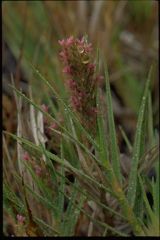
|
Cynodoneae (Gramma Tribe)
Distichlis spicata (Inland Saltgrass) W1 P2 N3 994 < sodgrass that spreads by scaley rhizomes < leaves stiffly 2-ranked, depart culm at 45º angle < sheaths longer than the internodes (overlapping) < seedhead is a contracted panicle < spikelets 5-9 flowered, white and shiny < distichlis = overlapping; spicata = spike-type inflorescence |
|
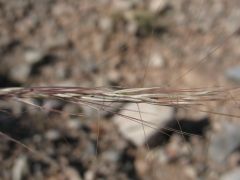
|
Aristideae (Threeawn Tribe)
Aristida purpurea (Purple Three-Awn) W P N 46 < mid-sized bunchgrass with mostly basal leaves; cespitose < narrow but loose panicle < 3 long awns per floret; one floret per spikelet < first glume about half as long as second glume < aristida = conspicuous awns; purpurea = reddish, purple |
|
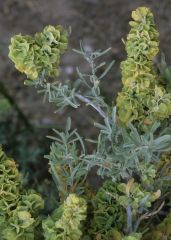
|
Chenopodiaceae (Goosefoot Family)
Atriplex canescens (Fourwing Saltbush) E P N 302 < mid-sized shrub loosely branched < plant is dioecious (plants either male or female) < leaves linear/oblong, straight and not twisted, folded or bent; occurring in fascicles < fruits with 4 papery notched wings (similar to Sarcobatus) < no thorns or spines as in A. confertifolia < atriplex is the ancient name used by Pliney for this genus; canescens = hairy-white/grey |
|
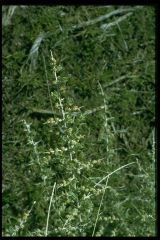
|
Chenopodiaceae/ Atriplex confertifolia (Shadscale Saltbush) C P N 304
< shrub forms a rounded clump with many spines < twigs with thorny tips < leaves orbicular/ovate (like a fish scale), not flat, salt covering “confetti” leaves < young branches yellowish, mature branches are scruffy, gray, and rigid < fruits and flowers not showy < “confert” = crowded or pressed together + “folia” = leaves |
|
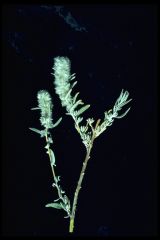
|
Chenopodiaceae/ Ceratoides lanata (Winterfat) C P N 308
< small suffrutescent plant or subshurb; stout cluster of branches < leaves linear/lanceolate, margins entire and very pubescent < lower side of leaves with a distinct midrib & enrolled margins < leaves alternate or in fascicles < inflorescence in a dense, hairy cluster; fruits are hairy balls < “cerat” = horn + “oides” = like a; lanata = wooly |
|
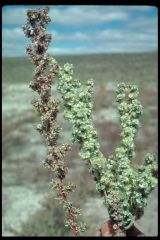
|
Chenopodiaceae/ Halogeton glomeratus (Halogeton) W A I 312
< small herbaceous plant with several branches all arising from center of plants < stems are usually decumbent at base; branches curve outward and upward from the base < mature plants have red or pink colored stems < leaves are round in cross-section, have a truncate apex, and possess a pointed bristle at the end (compare with Salsola) < fruits have tissues-like, yellow or reddish wings < “Halo” = salt + “geton” = neighbor; glomeratus = collected in heads |
|
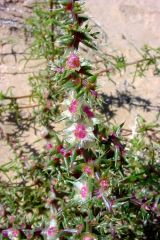
|
Chenopodiaceae/ Salsola iberica (Russian Thistle) W A I 318
< plant is much-branched and rounded in shape; forms a tumble weed < Flowers perfect, solitary < stems often red/green and striped; main stem waxy < single main stem at base the arises from a tap root; ascending or spreading, freely branching, green and purple or red striped, glaborus to short-villous. < leaves come to a sharp point and more or less clasp the branch; Alternate, simple; blades linear to filiform. < salsola = salty taste, salty habitat; iberica = from Spain or Portugal |
|
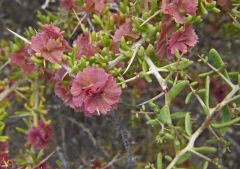
|
Chenopodiaceae/ Sarcobatus vermiculatus (Greasewood) W P N 320
< large shrub with white, spiny stems < stems usually diverge from main branch at 90º angles < leaves linear and fleshy, erect, and alternate < male flowers are dense spike-like catkins; female flowers are cone-shaped (look like petunias), reddish < “sarco” = fleshy + “batus” = a shrub or bramble; vermiculatus = “worm-like” |
|
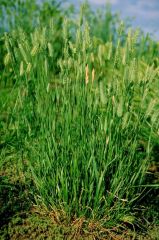
|
Triticeae (Wheatgrass Tribe)
Agropyron cristatum (Crested Wheatgrass) C1 P2 I3 1844 < strong bunchgrass with mostly basal leaves < inflorescence an uninterrupted spike < spikelets 5-8 flowered flattened, located sideways to rachis, overlapping < lemmas usually awn tipped, but awns are very small < agropyron = field wheat; cristatum = tassel-like at the tips, crested |
|
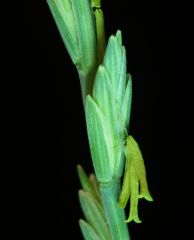
|
Triticeae/ Elymus hispidus (Intermediate Wheatgrass) C P I 190
< loose sodgrass spreading by rhizomes; can be rather tall (.4 - 1.2 m) < inflorescence a long spike, spikelets alternate, evenly spaced & not overlapping each other up the rachis < glumes and lemmas are blunt, lacking awns (unlike A. smithii which has short sharp awns) < nerves on spikelets are distinct, raised, thickened, obvious < elymus = millet-like grass; hispidus = with stiff hairs |
|
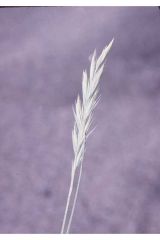
|
Triticeae/ Elymus smithii (Western Wheatgrass) C P N 192
< sodgrass spreading by rhizomes; mid-sized < leaves sharp pointed < spikelets on rachis slightly overlapping (more than A. intermedium) < spikelets 5 to 12 florets often having short, stout awns < spikelets wider than A. intermedium < nerves on glumes not raised or obvious as in A. intermedium < elymus = millet-like grass; smithii = named for Smith |
|
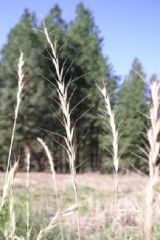
|
Triticeae/ Elymus spicatus (Bluebunch Wheatgrass) C P N 194
< mid-sized bunchgrass < spikelets do not overlap each other on the rachis as do A. cristatum and E. smithii < spikelets 4 to 8 florets; usually long and narrow < awns long (1-2 cm) and divergent at maturity < elymus = millet-like grass; spicatus = spike type inflorescence |
|

|
Triticeae/ Leymus cinereus (Great Basin Wildrye) C P N 202
< stout, tall (1-3 m), bunchgrass < inflorescence a spike, relatively continuous and uninterrupted < Elymus spp. have 3-5 spikelets per node on rachis, with a bristle at the base of every spikelet (unlike Agropyron spp. which have just 1 spikelet per node) < glumes are narrow, awn tipped < Lymus = an anagram of Elymus which this species was formerly classified as; cinereus = ashy-grey |
|
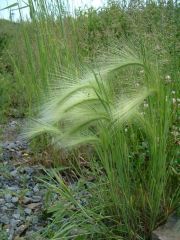
|
Triticeae/ Hordeum jubatum (Foxtail Barley) C P N 198
< mid-sized, tufted plant < inflorescence is dense, continuous, uninterrupted < each spikelets with long awns (1-6cm) and is subtended by long, delicate bristles; creates the fox-tail appearance < spikelets one-flowered; 3 spikelets per node < hordeum = latin name for barley; jubatum = crested with awns |
|
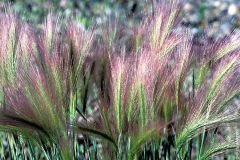
|
Triticeae/ Hordeum jubatum (Foxtail Barley) C P N 198
< mid-sized, tufted plant < inflorescence is dense, continuous, uninterrupted < each spikelets with long awns (1-6cm) and is subtended by long, delicate bristles; creates the fox-tail appearance < spikelets one-flowered; 3 spikelets per node < hordeum = latin name for barley; jubatum = crested with awns |
|
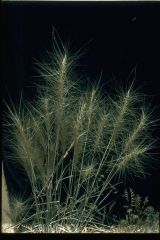
|
Triticeae/ Elymus elymoides (Bottlebrush Squirreltail) C P N 188
< densely tufted, mid-sized plant < inflorescence dense, continuous and uninterrupted, but is less dense (easier to see through) than Hordeum jubatum < interval between spikelets on rachis is more distant than between spikelets on H. jubatum < awns stiffer and more barbed than H. jubatum < spikelets 2-6 flowered; 2 spikelets per node < spikelets long awned (2-10cm), wide-spreading < at maturity awns and bristles diverge creating a bottlebrush appearance < well developed auricles around collar, purplish color < elymus = millet-like grass ; elymoides = grass-like |
|

|
Triticeae/ Taeniatherum caput-medusae (Medusahead Rye) C A I 204
< weak, small, bunchgrass; weak culms, branching at the base < each spikelets have 2 florets and florets have 5-10cm long awns < each spikelet is subtended by a crown of bristles < bristles are shorter than awns so forets looks like it has two sizes of awns < “taeni” = a ribbon = “therum” = a wild beast; “caput” = “head” + "Medusa" the Greek mythological woman whose hair was turned to snakes and whose stare turn objects to stone |
|
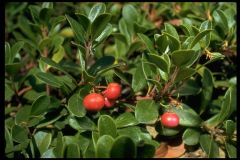
|
Ericaceae (Heath Family)
Arctostaphylos uva-ursi (Bearberry) E P N 338 < plant that grows as ground cover < red, “shreddy” bark < leaves tear-shaped; rounded at tip (without point) < leaves leathery; upper surface bright green, lower surface pale; roadmap veination < fruit a bright red berry < Arctostaphylos = arktos meaning "bear" + staphule meaning "a bunch of grapes"; “uva” = berry + “ursi” = bear; both names probably refer to bears eating the fruits of this plant |
|
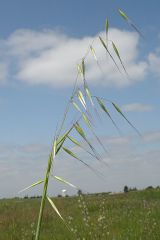
|
Aveneae (Oat Tribe)
Avena barbata (Slender Oats) C1 A 2 I 3 504 < loose bunchgrass, annual growth form; not as robust as A. fatua < seedhead is a panicle that is open, loose and has curved branches < spikelets large and 2-flowered; more slender than A. fatua < each lemma has a long black awn, usually bent once (once geniculate) < lemmas taper into two long and narrow teeth (A. fatua has shorter lemma teeth) < Avena means “nourishment”; barbata = “with tufts of hair, bearded” |
|
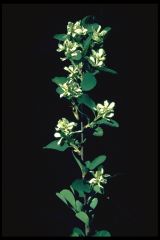
|
Rosaceae (Rose Family)
Amelanchier alnifolia (Serviceberry) C P N 402 < shrub or small tree < leaves are elliptic to oval with square cut tips; leaf margins are serrated or dentate above the middle half of the leaf (shaped like Bart Simpson’s head) < flowers white in small racemes < fruits are fleshy berries, yellow, red, blue, or black < stems are usually reddish-brown, glabrous, and rigid < Amelanchier translates to a=”not” + melan=”black + chier=”a hand” referring to a “not black” (or lite colored) “hand” (or leaf); alnifolia = alni=”alder” + folia=”leaf” |
|

|
Rosaceae/ Cercocarpus ledifolius (Curlleaf Mountainmahogany) E P N 404
< shrub or small tree with stiff branches; plant is evergreen < leaves sharp-pointed, lance-shaped, and leathery in texture; leaves alternate or whorled < leaves dark green above and silvery below with rust-colored hairs on underside of leaf < leaves with in-rolled margins (revolute), prominent mid-rib in center of leaves on underside < fruits with long, wavy, feathery style < bark reddish and stiff; note rings that form at base of leaf-bearing branches (looks like socks that feel down around ankles) < Cercocarpus = cerco=”like a tail” + carpus=”fruit”; ledifolius = ledi=”like lead” + folia=”leaf” |
|
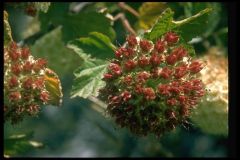
|
Rosaceae/ Physocarpos malvaceus (Ninebark) C P N not
included < spreading or erect, medium-sized shrub < leaves alternate with 3 palmate lobes; maple-like or current-like < leaves dark green above, paler and hairy below < bark loose and shreddy; brown to gray < Physocarpus = physo=”bubble or air bladder” + carpos=”fruit”; malvaceus = “like a mallow” |
|
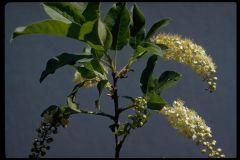
|
Rosaceae/ Prunus virginiana (Chokecherry) C P N 414
< shrub or small tree < leaves oval with many small, sharp serrations on margins < leaves are broad, end with an abrupt acuminate tip. < flowers white in short, dense racemes and fruits are juicy, red to black (delicious) < stems are slender, smooth and reddish-brown with prominent white lenticels < Prunus is the Latin name for plum; virginiaina = “from Virginia” |
|
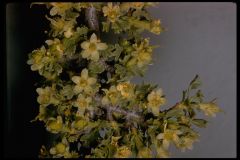
|
Rosaceae/ Purshia tridentata (Antelope Bitterbrush) E P N 418
< small highly branched shrub < leaves are crowded and appear fascicled < leaves are wedge-shaped and 3-lobed with in-rolled margins < green and hairy above; densely white-woolly beneath with prominent veins that form a “chicken foot” on leaves < fruits are enclosed in beaked shells; flowers yellow < Purshia = named after Frederick Traugott Pursh a Saxon botanist who received the plant collections from the Lewis and Clark expedition and was the first to publish on them; tridentata = tri = “three” + dentate = “toothed” |
|
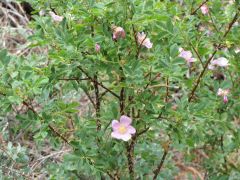
|
Rosaceae/ Rosa woodsii (Wild Rose or Woods Rose) C P N 420
< small shrub forming thickets < stems with straight or recurved with prickles (prickly all over) < compound leaves odd-pinnate, with 5-9 leaflets that are sharply serrated, leaflets opposite < look for prominent stipules at the base of the leaves < fruit a red, fleshy, rounded "hip" (an achene) used in tea < flowers pink or red < Rosa is the Latin name for rose; woodsii = named for a person named Woods |
|
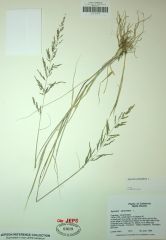
|
Aveneae (Oat Tribe) - Continued
Agrostis stolonifera (Redtop Bentgrass) C1 P2 I3 484 < sod-forming mid-sized grass, with scaly white rhizomes < pyramidal spreading panicle, lower panicle branches are whorled < culm nodes are often red or purple < florets one-flowered < glumes nearly equal, longer than lemma, pointed, stay open at maturity < Agrostis = “field grass”; stolonifera = “spreading by stolons or rhizomes” |
|

|
Aveneae/ Calamagrostis rubescens (Pinegrass) C P N 56
< ceaspitose grass with creeping rhizomes < leaves involute and ascending with drooping tips < base of culms often purplish < tuft of hair at blade collar (most apparent in the field) < inflorescence a contracted purple panicle; panicle is “interrupted” (bunched) < florets one-flowered < delicate awn showing between the glumes < Calamagrostis translates Calama=”reed” + grostis=”grass”; rubescens = “turning red” |
|
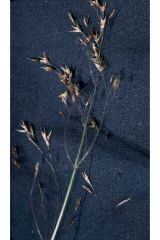
|
Aveneae/ Deschampsia caespitosa (Tufted Hairgrass) C P N 58
< tufted plant with mostly basal leaves < seedhead is an open panicle < florets 2-flowered spikelets, tips of lemmas are blunt and ragged < each lemma has a delicate awn arising from its base; gently bent awn < glumes have purple bands < Deschampsia was named for French naturalist Deshamps; caespitosa=”tussock-forming” or “bunchgrass” |
|
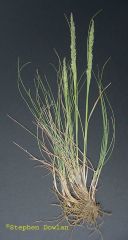
|
Aveneae/ Koeleria macrantha (Prairie Junegrass) C P N 62
< strongly tufted plant; usually mostly basal leaves < seedhead is a contracted panicle, narrow, spike-like; often shiny! < spikelets 2-5 flowered (appear one-flowered to the untrained eye) < spikelets have no awns < Koeleria was named for German botanist L. Koeler; macrantha = macr=”large”+ antha=”flower” |
|
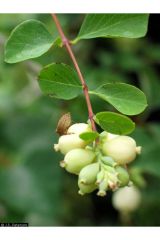
|
Caprifoliaceae (Honeysuckle Family)
Symphoricarpos albus (Snowberry) C P N 298 < small (to 1 m tall) thicket-forming shrub < opposite leaves (a family characteristic) < leaves ovate with entire margins < pink flowers and white fruits are terminal < bracts at base of leaves are hairy and shiny < twigs erect slender and yellowish-brown < Symphoricarpos=”with clustered berries”; albus = “white” (i.e., white berries) |
|
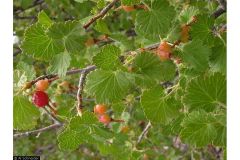
|
Grossulariaceae (Currant or Gooseberry Family)
Ribes cereum (Wax Currant) C P N 374 < relatively small shrub, much-branched < leaves are fascicled, orbiculate with crenate-dentate margins < upper leaf surface shiny (waxy); lower surface hairy, white, waxy gland dotted < stems are spineless and glabrous < fruit is a red berry; flowers greenish white to pink < Ribes is the Persian name for “acid-tasting”; cereum = “waxy” |
|
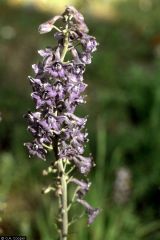
|
Ranunculaceae (Buttercup Family)
Delphinium occidentale (Tall Larkspur) W P N 390 < tall, robust forb with hollow stems < leaves palmately divided on long petioles, point-tipped leaves < leaves alternate, evenly spaced on stem (not all basal) < flowers on long racemes, dark bluish-purple, with spurs < Delphinium = “Dolphin-head”; occidentale=”western" |
|

|
Aveneae (Oat Tribe)
Phalaris arundinacea (Reed Canarygrass) C1 P 2 N3 644 < tall grass (up to 2 m), spreading by long scaley rhizomes to form large colonies < light green, finely veined leaves < sheaths pinkish and at overlapping at base < seedhead is a panicle, rather contracted and dense < spikelets have 1 fertile floret, awnless < glumes are big enclosing the whole floret; 3-nerved with a scabrous mid-nerve < Phalaris = “helmet-ridge” (referring to floret); arundinaceae means “reed like” |
|
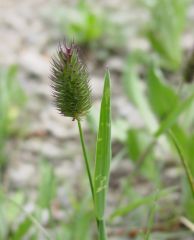
|
Aveneae (Oat Tribe) Phleum alpinum (Alpine Timothy) C P N 66
< tufted plant, culms often bulbous at base; mid-sized (15-60 cm tall) < inflorescence is a dense, spike-like panicle; purplish < panicle usually not more than twice as long as wide < florets 1-flowered, elliptic and somewhat flattened < awns on glumes about ¾ the length of the glumes < "V" shaped notch where glumes join < Phleum = copies (referring to dense seedhead); alpinum = “of mountain pastures” |
|
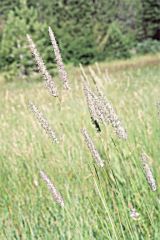
|
Aveneae (Oat Tribe) Phleum pratense (Timothy) C P I 68
< introduced forage grass, tufted; rather tall (0.5-1.2 m) < inflorescence is a dense, spike-like panicle (usually not as purple as P. alpinum) < panicle often several times longer than wide < awns on glumes less than ½ the length of the glumes < "U" shaped notch in the spikelets where glumes join < Phleum = copious (referring to dense seedhead); pratense =”of meadows” |
|
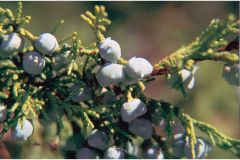
|
Cupressaceae (Cedar Family)
Juniperus scopulorum (Rocky Mountain Juniper) E P N 328 < dioecious shrub or small tree (to 12 m tall) < leafy twigs relatively slender, about l mm in diameter or less < leaves are scale-like, leaf margins are entire < male cones are inconspicuous, solitary at the tips of branches < mature fruits are berry-like, bright blue to purplish < Juniperus is the Latin name for juniper; scopulorum = “of cliffs and rocks” |
|
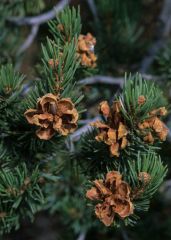
|
Pinaceae (PineTribe)
Pinus edulis (Pinyon Pine or Piñon Pine) E P N 382 < small tree (up to 15 m tall), pyramidal to spreading crown < smooth twigs when young, bark thin, gray to reddish brown < twisted trunk and crooked < short linear needles (1.2-5 cm) curved upwards; 2 needles per fascicle < large edible fruits (nuts) in cones < Pinus is the Latin name for pine; edulis means “edible” |
|
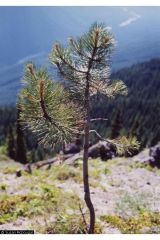
|
Pinaceae (PineTribe) Pinus ponderosa (Ponderosa Pine) E P N 384
< tree (up to 60 m tall), crown open, usually losing lower branches < bark is reddish-brown to cinnamon < needles 2 or 3 per fascicle, needles pretty long (10-28 cm) < cones globe-shaped with sharp prickles < seedlings look like grass < Pinus is the Latin name for pine; ponderosa = “very large” or “pondorous” |
|
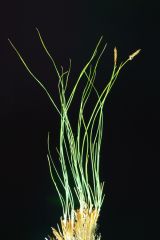
|
Cyperaceae (Carex Family)
Carex filifolia (Threadleaf Sedge) C1 P2 N3 2084 < grass-like herb; densely caespitose herb < base of plant densely sheathed with a rusty color < leaf blades rolled, thin leaves < flowers in solitary terminal spikes above leaves < florets are unisexual; female spikelets rounded at base of inflorescence, male spikelets slender above < black fibrous roots < Carex means “cutter” for the sharp leaf edges; filifolia is threadlike (fili) leaf (folia) |
|
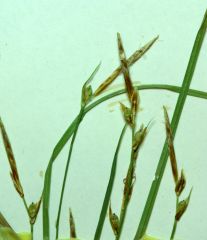
|
Cyperaceae (Carex Family) Carex geyeri (Elk Sedge) C P N 210
< grass-like herb growing in dense patches; plants with scaley, stout rhizomes < leaves not rolled, but are flattened or channeled < inflorescence arises below longest leaves (not extending above leaves) < florets are unisexual; male spikelets in solitary terminal spikes; female spikelets rounded and a short distance below the rest of the inflorescence < stems sharply triangular, stiffly erect < plants with scaley, stout rhizomes < Carex means “cutter”; geyeri was named for Geyer, and Austrian botanist who collected plants in the Northwestern United States. |
|

|
Cyperaceae (Carex Family) Carex nebrascensis (Nebraska Sedge) C P N 212
< grass-like herb spreading by rhizomes < large plant with long flat leaves < leaves pimple-dotted at base < female flowers at base of inflorescence stalk, each located in a sheath (spathe) < male flowers large, distinctly above female flowers < stems triangular and stiff < Carex means “cutter”; nebraskensis = “of Nebraska” |
|
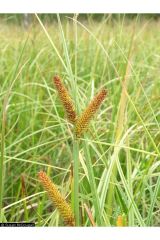
|
Cyperaceae (Carex Family) Carex utriculata (Beaked Sedge) C P N 214
< large grass-like herb with a stout culm; mostly cespitose but possessing white rhizomes < distinct septate nodules (little textured rectangles) on leaves < male flowers distinctly above female flowers < female flowers in axils of upper leaves (actually are leaf-like bracts) < Carex means “cutter”; utriculata = “with blatters” |
|
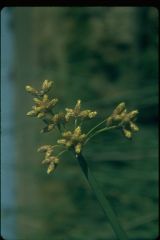
|
Cyperaceae (Carex Family) Schoenoplectus acutus (Hardstem Bullrush) C P N 216
< grass-like herb forming dense colonies from stout creeping rhizomes < culms round, stout, and scapose (leafless); acute at the tip (hence the name acutus) < inflorescence in panicle near tip of culm; culm extends beyond inflorescence < spikelets, unlike Carex, are prefect < flowers brown, scaled, cone-like < Schoenoplectus = schoinos for "rush, reed or cord" + plektos for "twisted, plaited"; acutus = “with a pointed tip” |
|
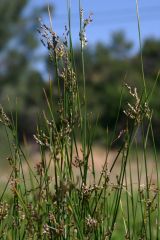
|
Juncaceae (Rush Family)
Juncus balticus (Wire Rush or Baltic Rush) C P N 218 < grass-like herb spreading from very aggressive creeping rhizome < leaves basal and reduced to blade-less sheaths < stems round and leafless < flowers perfect; appearing plump and ovate; straw-colored or dark brown < flowers/seeds in a cluster several inches from tip of stem < Juncus = “benders”, named for use in waving baskets; balticus = “from the Baltic region” |
|
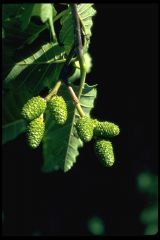
|
Betulaceae (Birch Family)
Alnus incana (Thinleaf Alder or Mountain Alder) C P N 292 < shrub or small tree (up to 10 m); often with multiple stems < leaves ovate with prominent veins; margin sharply double toothed < gray smooth bark < monecious plant; male catkins pendulous and finger-like; female catkins oval, erect and cone-like; both male and female catkins are dark brown woody and persistent < Alnus = “bountiful”; incana = “quite gray, hairy-white” |
|
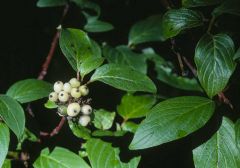
|
Cornaceae (Dogwood Family)
Cornus sericea (Red-Osier Dogwood) C P N 324 < shrub, highly branched, spreading by stolons, stems smooth red < opposite leaves, ovate to oblong (somewhat lanceolate) < leaves somewhat pubescent when young, glabrous at maturity < flowers (dull white) and fruits (white or gray) arranged in cymes < Cornus is the Latin name for the cornelian cherry; sericea - “silky hairy” |
|
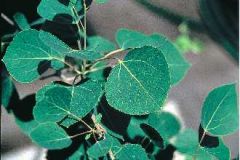
|
Salicaceae (Salix Family)
Populus tremuloides (Quaking Aspen) C P N 422 < tree with erect trunk; long and slender outline; crown of tree rounded < bark is smooth, greenish, gray or white; stems with large, red, shiny, resinous buds < leaves broadly ovate (nearly round) with a point at the apex < leaves are on long, strongly flattened petioles that are weak and are easily tossed in the wind (hence the common name "quaking") < fruits in drooping catkins < Populus is the ancient name for populus trees; tremuloides = “trembling or shaking” |
|
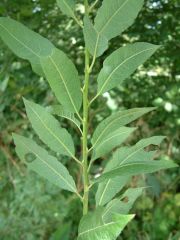
|
Salicaceae (Salix Family) Salix bebbiana (Bebb Willow of Beaked Willow) C P N 424
< shrub (up to 4 m tall) with mostly erect stems < leaves simple, alternate, oblong to eliptic (acute tip) < young leaves hairy, older leaves pubescent to glaborous < fruits (hairy capsules) and flowers in catkins < stems sometimes hairy or otherwise glabrous < Salix is the Latin name for willows; bebbiana perhpas named for someone named “Bebb” |
|
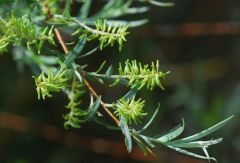
|
Salicaceae (Salix Family) Salix exigua (Coyote Willow or Sandbar Willow) C P N 426
< shrub (up to 7 m tall); stems and branches spreading, spreading by rhizomes < leaves simple, alternate, linear to lanceolate; blades mostly sessile < fruits (hairy capsules) and flowers in catkins; flowers abundant in upper leaf axils < stems reddish brown to gray and glabrous < Salix is the Latin name for willows; exigua = “very small and meager” |

